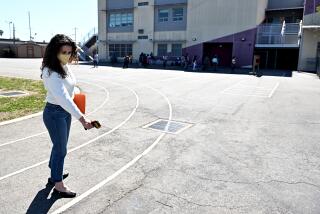State’s Voters Show Support for Schools
With their narrow approval of a $12.3-billion statewide school construction bond measure in Tuesday’s election, California voters reaffirmed their traditional support for education -- but just barely.
Locally, voters were less ambivalent, passing many -- though not all -- district school bond measures with comfortable margins. Los Angeles Unified School District’s $3.87-billion Measure R, for example, garnered more than 63% of the vote.
But did the statewide Proposition 55’s whisker-thin victory margin -- less than 57,000 votes out of the nearly 5.6 million cast -- signal a wavering in voters’ willingness to keep shelling out for schools?
Most analysts reviewing results Wednesday said no. They cited a possible one-time-only cause for the close call that might have made voters leery of even more debt: the presence on Tuesday’s ballot of the successful Proposition 57, the $15-billion state bailout bond. (Local school bonds are paid back through additions to property tax bills and have no claim on state funds.)
Jack O’Connell, the state superintendent of public instruction, saw strong support for schools even in the slim 50.6% margin for Proposition 55, which kept supporters in suspense as the close count dragged on into the early morning Wednesday.
“At a time when voters were asked to approve historic levels of debt, these results show what Wall Street and the financial community know: An investment in the future of our children is worth the interest and more,” O’Connell said in a prepared statement Wednesday.
Kim Rueben, a research fellow with the Public Policy Institute of California specializing in school finance issues, agreed.
“Proposition 55 got a back seat” to the bailout bond measure, Rueben said. “Voters were probably suffering from some sticker shock.”
“But I think there is still general support for schools,” she said.
However, Bruce Fuller, professor and co-director of Policy Analysis of California Education, headquartered at UC Berkeley and Stanford University, said educators were surprised and frightened by how close the vote on Proposition 55 was.
“At first glance, voters look schizophrenic,” Fuller said. “Thousands voted ‘no’ for the state education bond and ‘yes’ for their local education bonds,” an indicator, perhaps, that schools need a “strong dose of belt tightening,” he said.
Lawrence Picus, a USC professor in the Rossier School of Education, also believed Proposition 55 was hurt by the presence of Proposition 57.
But Proposition 55’s passage shows that voters still want to improve their schools, he said. “Generally speaking, voters are supportive of schools, and this is the one place today where they’re allowed to express that support,” he said.
Proponents, led by the California Teachers Assn. and other education groups, spent about $10 million to campaign for Proposition 55. It is the second bond measure in two years to fund a massive building and renovations program for schools, community colleges and the state’s two university systems. In November 2002, a $13-billion statewide bond won with more support, 58.9% of the vote.
Most local school bond measures on Tuesday’s ballots had an easy time, despite needing 55% of the vote instead of the 50% majority required for state bond measures.
Statewide, 47 of 61 school and community college district bond measures won approval, according to the consulting firm School Services of California.
The victory of L.A. Unified’s Measure R was the third such bond to pass in the district since 1997, bringing the total from the three to nearly $10 billion for school construction, expansion and renovations. For property taxpayers, Measure R is projected to add $60 a year for each $100,000 in assessed property valuation over 30 years, in addition to the extra $100 per $100,000 from the previous two measures.
Supporters raised $1.7 million, including about $220,000 from United Teachers Los Angeles and the CTA, for the Measure R campaign, and they enlisted backing from a broad group of civic, political, business and education leaders.
When the proceeds from all three recent local bonds are combined with L.A. Unified’s share of the matching funds from Proposition 55, the 750,000-student district is expected to have some $13 billion for a multiyear building and remodeling program, officials estimated.
“It’s a tremendous vote of confidence in our district, and I really appreciate it,” an exuberant L.A. district Supt. Roy Romer said.
In Orange County, two of three district bond measures on the ballot won voter approval, including Saddleback Valley Unified for $180 million in school improvement funds, with 59% of voters agreeing to a $37 annual tax increase for every $100,000 in assessed property value. Similarly, landowners in the Huntington Beach Union High School district will pay a $30 tax increase to cover $238 million in repairs and modernizations at the eight district campuses.
But voters in Orange Unified rejected a $200-million bond measure. So did voters in the Acton-Agua Dulce district in northern Los Angeles County, who voted down a $13.1-million measure.
Parcel taxes to help operate schools -- which need two-thirds of the vote to pass -- fell short in La Canada Unified (where voters simultaneously approved a construction bond measure on the same ballot, giving each measure about 63% of the vote) and in Walnut Valley Unified.
Statewide, 20 school parcel tax measures were on Tuesday’s ballot, according to School Services, and only seven of them met the two-thirds vote required for passage.
One district where voters passed a parcel tax was Las Virgenes Unified, which straddles Los Angeles and Ventura counties. The $1.9-million tax will allow the district to avoid laying off counselors and teachers, according to Supt. John Fitzpatrick.
“It was a terrific community effort,” Fitzpatrick said. “Everybody got involved.”
Times staff writer Joel Rubin contributed to this report.
More to Read
Get the L.A. Times Politics newsletter
Deeply reported insights into legislation, politics and policy from Sacramento, Washington and beyond. In your inbox three times per week.
You may occasionally receive promotional content from the Los Angeles Times.











